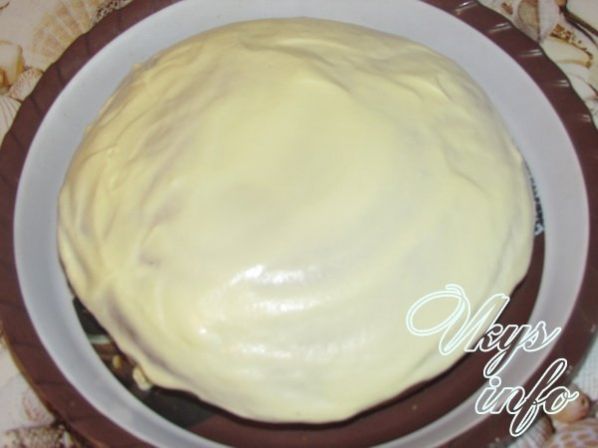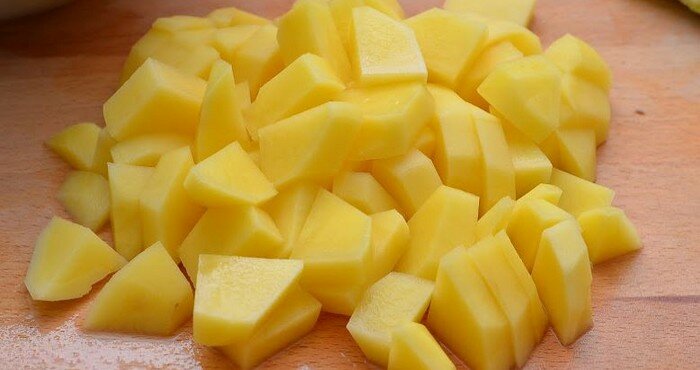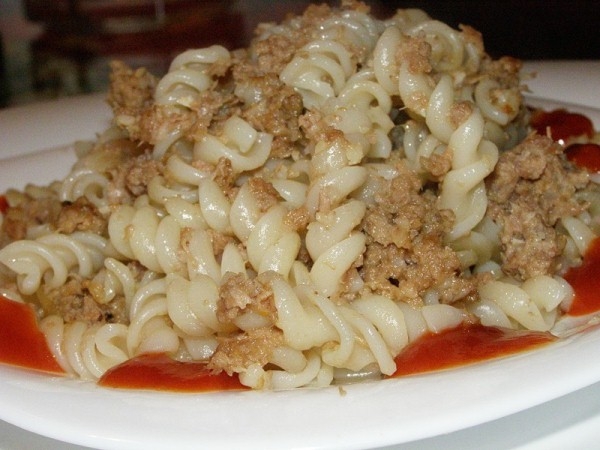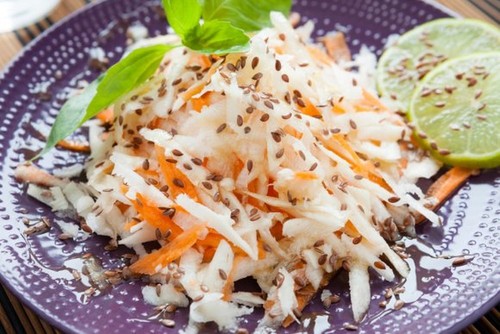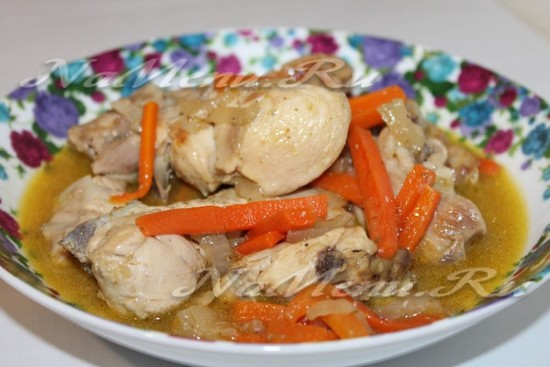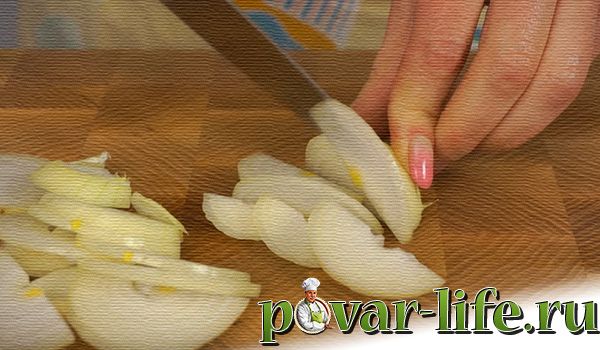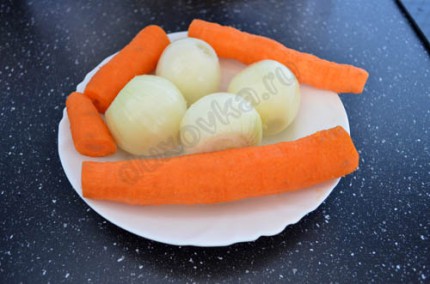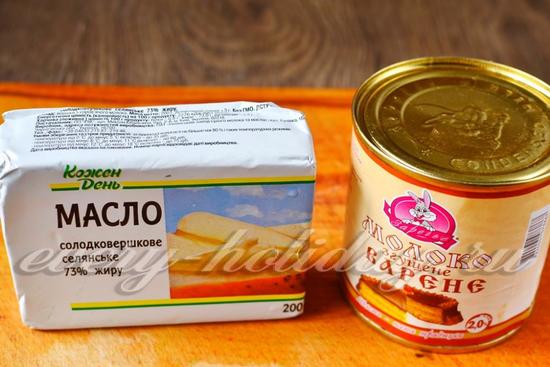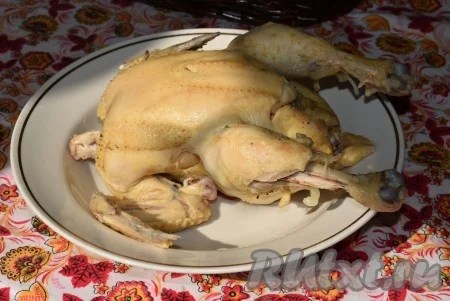Easter cottage cheese - cooking recipes.
Cottage cheese Easter is a delicate, airy, very tasty Easter table dish. All the secrets of cooking - with us!
- 1 kg of cottage cheese
- 3 egg yolks
- 150 g sour cream 30%
- 1 cup of sugar
- a pinch of salt
- 1-1.5 cups of raisins
- dried apricots and prunes for decoration

Rub the curd.

In a separate bowl to pour the egg yolks sugar.

Grind the sugar with yolks, add salt.

Add the egg mass to the curd, mix.

Run sour cream. If shop sour cream, it is better to take fatter - 30%.

Rinse the raisins, give it a little dry. Combine with curd mass.

Stir until smooth.

Prepare a form for Easter. You can use any utensils that have a hole for draining excess liquid.

Colander put on a bowl (or, for example, a salad bowl), which will drain the serum.
Put a clean gauze folded in half in a colander. Marley should be enough to completely cover her Easter.

Put the whole curd mass on gauze, level the top.

Cover Easter with gauze.


Put a press on top.

Let Easter run into the cold for several hours (or a day). Open gauze.

Top the colander to put the dish upside down and gently turn the colander. Remove the gauze.

Decorate Easter with dried apricots and prunes.

Recipe 2: Easter cheese with condensed milk
- cottage cheese - 400 gr
- butter - 150 g
- sour cream - 150 gr
- boiled condensed milk - 400 gr
- raisin - 100 gr

Fill the raisins with hot water and leave for 10-15 minutes.

Cottage cheese, butter, sour cream and condensed milk combine in a bowl. All products must be at room temperature.

Beat with a mixer until smooth.

Rinse the raisins and add to the curd mass.

Pashochnitsa, bowl, colander or sieve lining gauze in several layers.

Put the curd mass into the gauze.

Pasochnitsu put in a deep dish, wrap cheesecloth, put a plate on top, and put a load on it. Put in a cool place for a day.

Unroll the gauze and turn the easter over on the dish. Carefully remove the crochet and remove the gauze. Enjoy your meal!

Recipe 3: Easter curd on cream
Very simple and sufficient quick cooking recipe.
- cottage cheese 1 kg
- granulated sugar 200 g
- chicken eggs yolks 4 pcs.
- home cream floor liter jar
- additives to your taste: raisins, prunes, dried apricots, nuts, candied fruit, etc.
- you can add berries, bananas, oranges, kiwi, peach anything you like
- butter 300 grams
- bag of vanillin or vanilla sugar

Shake the cottage cheese in two layers of gauze and put under the press for about 6 hours, should leave the excess liquid.

Rub the curd through a sieve.


Homemade cream 250 g mixed with four yolks. Heat the second part (another 250 g) of the cream over the fire, but do not bring it to a boil.
In a well-heated cream enter the creamy-egg mixture, mix and hold on the fire for another 2-3 minutes, the mass should thicken. Remove from heat. Grind butter and sugar with sugar.

Raisin pour boiling water, then put on a napkin dry. Dried apricots and fruits are not cut into large cubes.

Add mashed butter and vanilla sugar to the grated curd, mix, pour in the cream and beat thoroughly with a mixer to form a fluffy mass of uniform consistency. Pour candied fruit, raisins.

Stir once more so that they are distributed evenly over the curd mass.
Forms to cover with wet gauze.
In the prepared forms for Easter, tamp down the curd mass, put the oppression on top and stand in the refrigerator for 11 hours.
After getting the cottage cheese cake out of shape, decorate with fruits or sweets on top and serve.

Recipe 4: Easter cheese with dried apricots and candied fruits
- cottage cheese - 1.5 kg;
- sugar - 1 kg;
- eggs - 10 pcs .;
- butter - 200 grams;
- sour cream 25% fat (it is better to use homemade) - 0.5 liters;
- vanilla sugar - 1 pack;
- raisins - 2 glasses (you can more - an amateur);
- dried apricots, candied.

Curd cheese rubbed on a large grater or through a sieve until a homogeneous mass.

Drive eggs into a separate container.

Add sugar to eggs, whisk whisk until smooth.

Add the resulting mass to the curd.


Mix well.

Melt the butter in a water bath or in a microwave, add to the cottage cheese.

All components are gently mixed and set on the minimum fire. Constantly stirring, bring the mixture to a hot state, preventing boiling.

After cooling a little, pour the contents into a bag of cloth (you can use a clean pillowcase or gauze folded in several layers) and hang it for at least 12 hours to remove excess moisture (if the curd is very wet, you can use oppression).

The raisins are thoroughly washed under running water, dried. Dried apricots washed, cut into small pieces.

We spread cottage cheese Easter in a vase in layers, alternating with raisins.

The top layer of Easter is raisins. Add dried apricots and candied fruits.

Curd Easter is ready to eat! Keep it in the refrigerator.

Recipe 5: Easter with brewed fudge (step by step photos)
- 500 g of fat cottage cheese (it is better not to take sour cottage cheese),
- 3 eggs,
- 1 cup of sugar,
- 200 ml of cream
- lemon juice,
- vanillin,
- raisins,
- dried fruits,
- candied fruit,
- 100 g butter

Cottage cheese fray through a sieve or scroll 2 times in a meat grinder. The easiest way is to grind cottage cheese for Easter with a blender to a pasty state.

Dried fruits pour boiling water, in order to get out of them all the chemicals. Flush. Grind with a knife. If you add chopped prunes to curd Easter, keep in mind, it will give a creamy tint to the curd. Squeeze the juice out of the lemon and remove the bones if they got there.

Add dried fruits, candied fruits, raisins and lemon juice to grated curd.
All mix.

For custard, beat eggs and sugar into foam (about 5 minutes). Add cream to them, mix. We put in a water bath or just a slow fire. Add vanilla, about one small bag.

Constantly stirring, boil custard fudge for Easter cheese to a state of liquid mashed potatoes.

Remove and immediately pour hot fudge into the cottage cheese. This is the brewing process. Quickly mix. In the cooled mass for boiled curd Easter, put the softened butter and knead.

The form is lined with several layers of gauze, leaving long ends. We spread in her curd mass, close the top ends of the gauze.

Put under pressure in the fridge for 12 hours. During this time, excess moisture will flow through the holes in the mold.

Curd Easter turn over on a dish and decorate.
You can decorate with candied fruit, marmalade, nuts, or just melted chocolate from a pastry bag or syringe for a cream to draw a pattern.

Recipe 6: Tsar's Easter Easter Cheesecake (with photo)
- 0.5 kg of cottage cheese
- 100 grams of butter
- 2 chicken eggs
- 3 tablespoons sour cream
- 100 g sugar
- A pinch of salt
- 1 packet of vanilla sugar
- ¼ cup raisins
- ¼ cup walnuts
- Lemon and orange peel

Half a kilogram of fresh good cottage cheese to grind together with 100 g of sugar sand to a homogeneous mass (you can fork, spoon). The softened butter to grind until white with vanilla sugar.
Tip: Butter butter must be softened at room temperature, naturally, not in a microwave oven or gas.
Wash lemon and orange thoroughly, wipe dry. Grate lemon and orange zest on a fine grater or special device. Finely chop the walnuts with a knife or chop them in a blender.
Add 2 chicken eggs and 3 tablespoons of chilled sour cream to the curd mass (the fatter the sour cream, the thicker it will be, so take it on board). Mix everything well with a tablespoon.
Add butter, whipped with vanilla sugar. Stir once more.
Add chopped walnuts, pre-soaked raisins and citrus zest. Mix well.
Take the form for Easter. Cover the form with wet gauze folded in half or cotton cloth so that the edges hang down (moisture gauze is needed so that the finished cheese Easter cake can be easily removed and completely retains its original appearance). Put the curd-citrus mixture in the prepared pasochnitsa.
Cover the mixture with the remaining corners of the gauze. Put everything under pressure at night in a cool place (in the refrigerator). On good, Easter should stand under the yoke for at least 12 hours.
Recipe 7: simple curd Easter (step by step with photos)
Sweet, creamy texture of Easter cheese is very similar to ice cream. Despite the fact that it is not difficult to cook it, but the cottage cheese Easter matures for 2 days.
- Cottage cheese - 450 grams;
- Butter - 200 grams;
- Sugar - 170 grams (or to taste);
- Yolks - 3 pieces;
- Cream - 200 ml;
- Candied fruit - 30 grams;
- Raisin - 70 grams;
- Vanilla sugar - 1 bag.
Cottage cheese 2 times wipe through a sieve to get rid of the grains and achieve a smooth, creamy texture. Even if you buy a curd without grains, it is still necessary to wipe it through a sieve.
Beat yolks with a small amount of sugar until white.
Add softened butter, sugar and whisk again until smooth.
Whip up the mass with mashed cottage cheese.
Separately, whip the cream until strong peaks.
Add cream to the curd mass, stir until smooth.
Add the washed and dried raisins and candied fruits.
Try to distribute everything as evenly as possible so that the raisins and candied fruits do not sink to the bottom or rise up.
Wash, collect and place the mold for cottage cheese easter on the inside with wet gauze.
Distribute gauze evenly, without assemblies, as the printed image will depend on it. The form we will have turned upside down. Put it on a plate or pan.
Slowly, one spoonful, spread the curd mass inside the mold. This should be done so that no voids form inside, so that all free space is filled evenly.
Fill the form to the end, leave a few spoons of filling. Easter will sink under the weight of the load and you will need to add cottage cheese.
Lay the hanging pieces of gauze neatly and evenly over the top of the filling. Put a plate on top and a load of at least 500 grams on it. And put this whole structure in the fridge.
Liquid will be emitted from the bottom, it should be immediately cleaned, and the plate should be wiped dry. Check the top of the form, if the filling has subsided, then add the remaining curd, again lay the plate and load on top. Usually the next day, the liquid is no longer allocated.
After two days, get the Easter from the refrigerator, free from the form and gauze. Curd Easter for the holiday is ready!
Recipe 8: Candied Easter Cheesecake
- Cottage cheese - 500 g
- Eggs (yolks only) - 2 pcs.
- Sugar - 125 g
- Butter - 100 g
- Sour cream (cream) - 100 g
- Vanilla sugar - 1 bag
- Dried fruits (candied fruits) - 100 g

Cottage cheese must grind through a sieve or grind blender (immersion nozzle). Cottage cheese will become airy and even more tender.

Soak candied fruits for Easter well with hot water and let stand for 30 minutes. Then drain the water, dry the swollen dried fruits and cut them if necessary.

All other ingredients (yolks, sour cream, butter, sugar) mix until smooth and put on fire. On medium heat, bring the mixture to a boil. Stir for about three to five minutes, the mixture should begin to thicken.

Then let it cool and mix with cottage cheese and candied fruit.
Clean gauze wet and squeeze. This is necessary so that it would be convenient to lay out a pasochnica, removing deep folds.
Pasochnitsu put in a deep bowl upside down, cover with gauze, leaving the edges hanging. Put the curd mass.

Cover the edges with gauze on top, put a small plate on top of a suitable size and put a yoke (2-3-liter jar of water). Put in a cold place for at least 12 hours. During this time, excess liquid will drain into the bowl, constantly it must be drained.

Then we open the gauze, substitute the dish where Easter will stand, and gently turn over and disassemble, remove the basket. Now cottage cheese Easter is ready, can be decorated with candied fruit.
Recipe 9: Easter cheese with poppy filling
The combination of poppy and cottage cheese is very harmonious, the curd layer is airy and tender.
- Cottage cheese - 400 g (fat)
- Cream - 200 ml (33-35%)
- Gelatin - 9 g (powder)
- Sugar - 275 g (125 g per cottage cheese, 150 g per poppy filling)
- Vanilla sugar - 1 tsp. (in cottage cheese and in a poppy filling 0.5 tsp)
- Mac - 300 g
- Milk - 120 ml
- Raisin - 100 g
- Nuts - 100 g
- Lemon peel - 1 tsp. (can be excluded)
- Water - 50 ml and a little more for gelatin

Soak the raisins in warm water to slightly swell. Chop the nuts into small pieces. With lemon remove the zest using a fine grater.
Grind poppy, you can do it with a coffee grinder, pour milk, add sugar, vanilla sugar, zest, raisins and nuts. Mix thoroughly, then heat.
Set aside the poppy mixture for 30 minutes to ripen.

For cooking Easter it is better to use fat cottage cheese. First, using a hand blender, grind it until smooth, smooth, and then add sugar, vanilla sugar and mix.

Gelatin Pour 50 ml of water. As soon as the gelatin swells, add a little more warm water. Heat the gelatin over low heat until it is completely dissolved, then strain the liquid.

Beat cream until hard peaks.
In the prepared cottage cheese to enter the gelatin and whipped cream, gently mix everything with a silicone spatula.

You can use a special form for Easter (pasochnitsa). In this case, using a pastry bag to distribute the curd mass in shape, leaving unfilled the middle. In the center lay out the poppy filling, from above you can distribute another layer of cottage cheese, level it. Send Easter in the fridge for a day.
If there is no special form, then take a colander, cover it with gauze. The colander itself should be put on a suitable size pot. ¾ pour curd mass into an improvised form. In the center of the form put poppy filling. Since it is heavier than cottage cheese, it will drop down a bit. Top poppy close layer of cottage cheese. Carefully level the surface. Send for freezing in the fridge for a day.
By the bright holiday of Easter. What to cook for the table, how to cook a homemade Easter without baking - find out today.
If suddenly you didn’t know, we’ll make it clear: Classic Easter cheese is a special dish made from cottage cheese, which is prepared only once a year - for the Easter holiday. The custom to cook cottage cheese Easter cake without baking is known in the central and northern regions of Russia, while in southern Russia and Ukraine Easter is called paskha. By the way, one of the most popular recipes is cooking at home.
The original form of Easter - truncated pyramid, symbolizing the Holy Sepulcher. Traditionally, for the preparation of cottage cheese Easter at home, according to the very first recipes, a special folding wooden form was used - a pasochnitsa. Today pasochnitsy can be found in free sale and from different materials.
The classic recipe for "Tsar's" Easter (cottage cheese)
The most important dish of the festive Easter table is Easter. The recipe for classic curd Easter "Tsarskaya" read on WANT.uaWhat we need:
- cottage cheese - 500 g
- 3-4 egg yolks (or 2-3 eggs)
- sour cream - 200 g
- butter (room temperature) - 100 g
- sugar - 100 g
- vanilla sugar - 1 tsp (or 1 tsp vanilla extract)
- raisins - 80 g
- nuts (almond petals or crushed peeled almonds, hazelnuts, cashews, etc.) - 50 g.
The classic recipe for "Tsar's" Easter (cottage cheese): how to cook
To prepare the classic royal Easter: wash the raisins, pour boiling water and leave for 20 minutes. Drain the water and dry the raisins on a paper towel. Cottage cheese rubbed through a sieve (can be minced twice or wiped with a blender).
Add yolks (or eggs), sour cream, sugar, vanilla sugar to the curd and mix well. Add diced butter and beat the curd mass with a mixer until it is pompous and homogeneous. Pour the cottage cheese into a thick-walled pot. Put on a small fire and cook, stirring constantly, until the first bubbles (i.e. before boiling).

Tip 1. It will be thick at first, but the more it is heated, the thinner it becomes - this is normal.
Tip 2. You should not boil the curd mass for classic Easter; you just need to bring it to the boil.
When the first signs of boiling appear, remove the pan from the heat, put it in a bowl of cold water (ice cubes can be added to the bowl) and stir until completely cooled. Cool down curd mass for 1-2 hours in the refrigerator so that it thickens.

Add raisins, nuts and mix well in the cooled curd basis of "Tsar's" Easter cottage cheese cake. Cover the pasochnitsa with gauze soaked in water and folded into 2 layers. Put the cottage cheese base for the recipe in the pasochnitsa.
Tip: instead of a pasochnitsa you can put the curd mass for Easter in a sieve or use a new flower pot (with holes in the bottom of the pot).
.jpg)
The edges of the gauze bend, flatten the Easter with oppression and put in the fridge for 1-2 days. Pasochnitsu need to put in a plate so that it could drain serum.
Recipe for classic cheese raw Easter

- cottage cheese - 500g
- butter - 200g
- sugar - 1 cup
- cream - 1/2 cup
- egg (yolk) - 2-3 pcs.
- raisins (pitted), almonds (crushed) - 1 tbsp.
- candied fruit, cardamom (ground), vanilla - to taste

So, how to cook cheese Easter: Grind butter with sugar until white, adding yolks one by one. Grind the mass until the sugar crystals completely dissolve, aromatize with vanilla or finely ground and sieved with cardamom. Add twice-grated cottage cheese, raisins, almonds, crushed orange candied fruits or grated lemon zest.

Mix thoroughly, add whipped cream, mix from top to bottom, fill in a bowl with a little damp gauze, close with a saucer, load with a small yoke, put in the fridge. Also among our readers is very much appreciated, which undoubtedly will further decorate your Easter table.
The recipe for a delicious Easter cheese without eggs (with strawberries)

- cottage cheese (fat content 9%) -450g
- sugar - 120g
- butter - 100g
- salt - 1/4 tsp.
- lemon (zest) - 1/2 pcs
- dried strawberries - 130g
- vanilla essence - 1/2 tsp
To cook Easter cake without eggs: put fresh curd in gauze, tie a bundle and hang over the sink so that the glass is serum. After that, rub the curd through a sieve so that the finished curd mass is softer.
Chop dried strawberries in a blender. The result is a homogeneous viscous gruel. Soften butter, grind to a thickness of sour cream, add sugar, salt, lemon zest and vanilla essence. Mixer to knead homogeneous light mass.

Put the butter whipped with sugar in a bowl of cottage cheese. Gently, moving the spoon from the bottom up, mix the cottage cheese with butter. Now you can add strawberries, mix again, so that the berries are evenly distributed in the curd mass.
Transfer the curd for Easter to a pasochnit lined with gauze, put it under a press and put it in the fridge for the night. If on a plate with Easter liquid will form, drain it. In the morning, turn the pasa bowl on a plate and remove the gauze. See also on WANT.ua for relatives and friends.
Curd Easter is cooked only once a year, on Pure Thursday, so that it stands up to Holy Christ's Resurrection. The hostesses make home-made cottage cheese and take out special detachable shapes in the form of a truncated pyramid - pasochnitsa, on the walls of which the letters XB and Christian symbols are carved. Then the drawings are printed on the finished Easter, and it looks very bright and impressive. Interestingly, Easter cake from cottage cheese is cooked only in the central and northern regions of Russia, and in the South Easter cake is usually called Easter cake. The form of Easter is a symbol of the Holy Sepulcher, so it reminds Christians of the sufferings and torments of Christ. It is believed that this dish is very difficult to prepare, but, as they say in one Russian proverb, the eyes are afraid, and the hands do. Let's talk about how to make Easter at home, so that it turned out to be not only delicious, but also beautiful and appetizing.
For the royal Easter - the best products
Buying ingredients for this dish, it is better not to save and choose the best and quality products. Cottage cheese should be very fresh, not sour, not dry, better than homemade. To do this, pour kefir into a boiling milk in a thin stream, and when the curd clots are separated from the whey, turn off the heat, close the pan with a lid, let the mass stand and cool. After that, we tilt the cottage cheese on a double layer of gauze laid out on the bottom of the colander, tie a gauze knot and hang it over the sink or pan for about a day. From 3 liters of milk and 3 liters of kefir (they are taken in equal proportions) is obtained about 1 kg of cottage cheese. But the weight of the finished product may vary depending on the quality and fat content of milk and kefir - the higher the fat content, the greater the curd. Also for Easter you may need cream and sour cream of 25%, unsalted butter of 82.5%, fresh eggs, sugar, honey, condensed milk, chocolate, marmalade, poppy seeds, dried fruits, nuts, candied fruits, berries, mint and spices - it all depends recipe.
Two ways to cook Easter

Curd Easter can be made in two ways - hot and cold, which means that Easter is raw and boiled. For raw Easter, cottage cheese is twice wiped through a sieve or ground in a meat grinder, then all products are mixed and placed under a press. Boiled Easter is not really cooked, but heated on the fire, then slowly cooled in a bowl with cold water. Since fresh cottage cheese is stored for a short time, it is better to make raw Easter eggs of a small size, whereas boiled ones can be spread in large forms - they retain their freshness and pleasant taste longer. By the way, Easter, cooked in a hot way, turns out to be more tender and sweet.
For the easiest raw Easter, take 2.5 kg of cottage cheese, wipe twice through a sieve, mix 200 g of butter with 1 cup of sugar until the mass becomes white and fluffy. Then add there 250 g of fat sour cream and continue to grind until the grains of sugar are completely dissolved. By the way, this is the main sign that it’s time to mix the mass with the curd, add a little salt and fill the pasochnitsa. From above we put a saucer with a load and send Easter to the refrigerator for 12 hours.
The easiest cooked Easter is made from 300 g of butter, 400 g of sour cream and 4 eggs. The mass with constant stirring is brought to a boil, then mixed with 2 kg of grated cottage cheese. A little salt is added to Easter, it is well mixed and put into shape. For such recipes, eggs are recommended to be taken fresh from healthy domestic chickens.
How to make Easter from cottage cheese: secrets and subtleties

If Easter is prepared from store curds, it is better to first hold it under the yoke to remove excess liquid. The hostesses who cook the cottage cheese leave it hanging for a day, as the whey remaining in the curd will prevent the mass from solidifying. It is not by chance that this dish was called Easter cheese in Russia - the curd should be quite dense and cut well with a knife.
Liquid sour cream can be laid out in several layers of gauze in a colander and put in the refrigerator. Sour cream should be so thick that there was a spoon in it, only in this case Easter will be stable. Butter should be kept warm in advance so that it becomes softer, dried fruit is well sorted, rinsed and dried, and nuts are freed from the skin. If sugar is replaced with powdered sugar, raw Easter will be softer and sugar will not creak on the teeth. For the same reason, all spices should be ground in a coffee grinder or bought in a ground form.
By the way, cottage cheese, mashed through a sieve, differs in consistency from cottage cheese, passed through a meat grinder. In the first case, it turns out to be very gentle, light and airy, in the second case - more viscous and dense.
Before laying the curd mass in a pasochnitsa, the bottom is covered with a linen napkin or gauze so that the edges hang out of the mold and Easter can be easily removed. It is better if the cloth is damp, otherwise folds may form that will ruin the Easter surface. From above, Easter is covered with the edges of the fabric and a wooden plate, the oppression must be laid and the mold is put into the cold for about 12 hours.
Sour cream Easter with condensed milk
Cooking boiled Easter at home

Unusually delicious Easter, which is soft and at the same time excellent in shape, will surely please your family.
In 500 g of cottage cheese, rubbed through a sieve, add 3 yolks, 100 g of sugar, 200 g of sour cream and a little vanilla, knead the mass well and beat in a blender so that it becomes tender and airy. Then cut into 100 g pieces of butter, add to the curd and beat again until smooth.
Now we put the saucepan on the fire and heat it very slowly, stirring constantly. Bring the curd mass to a boil and let it cool to room temperature in a large bowl of cold water, then put in the fridge for 3 hours.
Easter will thicken a little and get a pleasant texture. At this stage, we add to it 80 g of raisins, which are pre-washed and soaked for 20 minutes in boiling water.
We spread the curd mass in the form, put in the fridge for a day and serve on the table with raisins and marmalade.
Lazy Easter for busy housewives

It happens that there is no time to cook a real classic Easter, but how can you leave the family without Easter treats? Let's try to cook a quick Easter according to an unusual recipe - it turns out very delicate and fragrant.
So, carefully grind 2.5 kg of sour cream from 10-15 tbsp. l sugar, add vanilla, 150 g of any roasted nuts and 150 g of dried fruit, well washed and dried. Easter is especially tasty with dried cranberries and pine nuts.
And now we put the fabric in the pan - either 12 layers of gauze, or 4 layers of calico, or 2 layers of calico. Pour sour cream, collect the corners of the cloth and hang the mass in the refrigerator, using a cup stand, a basket with a high handle or other devices - you will have to strain your imagination and be smart. Sour cream should hang for 24 hours, but every 6 hours it is necessary to untie the cloth and mix the contents, since the sour cream thickens outside and remains liquid inside. It cannot be placed under a press, otherwise the whole Easter will flow out along with the serum. You can decorate this amazing Easter dessert with grated chocolate, nuts, berries and fruits.
How to serve Easter

Curd Easter can be decorated with gelatinous figures, pieces of chocolate, candied fruit and berries slices. The simplest decor is cinnamon, icing sugar, cocoa powder, poppy seeds and multi-colored coconut chips. For decoration, you can use nuts, dried fruits, roasted sesame, rose petals, mint sprigs. Easter looks very beautiful, decorated with edible beads, flowers and mastic figures. Dessert can be decorated with whipped cream, especially chocolate, M & M's sweets, confectionery powder, pour with melted chocolate or caramel. And you can just put a church candle in the middle, because Easter is beautiful in itself. Easter should be cut with a warm knife, constantly dipping it into warm water and wiping it with a napkin so that the pieces are smooth and beautiful on the cut.
Now you know how to make Easter eggs with your own hands, how to decorate it and properly serve on the table. Do not be afraid of complex recipes and get ready for the bright spring holiday, when not only nature but also our hearts come to life. May your Easter table always be generous, rich and tasty!
Calorie: Not specified
Time for preparing: Not specified
Traditional Easter cakes are prepared for the Easter holiday, they are dyeing little eggs, decorating the house and preparing all kinds of food. Curd Easter from the curd mass is also considered a traditional treat, which is loved by both adults and children. If you know, then Easter is made from cottage cheese, but today we will make Easter from curd mass. The treat will be tasty, sweet and tender, like a real dessert. Curd Easter is prepared for several hours, but it is better to leave it overnight in the refrigerator so that it takes the desired shape, settled down and turned out beautiful. Prepare all the products, plan the day and prepare a tasty festive treat. A detailed recipe with a photo will help you quickly and easily cook this delicious dessert. By the way, you can do it yourself.
Required Products:
- 500 grams of sweet curd mass,
- 150 grams of raisins,
- 1 tables. l sour cream
- 50 grams of butter,
- 150 grams of sugar,
- 0.5 Chin. l vanilla sugar.
Recipe with photos step by step:

Rub through a sieve curd mass. Usually, the curd mass is very soft, but I still rub it through a fine sieve so that Easter is tender. If you are confident in the purchased curd mass, then you can not fray. 
We pour granulated sugar to the curd mass, but it is not so much, as the curd mass can be sweet. Pour some vanilla sugar, but a little bit. Usually curd mass has a pleasant vanilla flavor. 
Add fat sour cream, it will give the softness and tenderness of Easter. 
Add soft butter at room temperature to the curd mass. I take the butter out of the fridge one hour before Easter, it will be soft and perfectly combined with cottage cheese. 
You will also need dried fruits, they are in perfect harmony with the curd mass: add raisins, washed and dried on napkins, but you can take any candied fruits or dried apricots. 
We shift in a special form the whole curd mass, which is thoroughly mixed. We line the mold with a damp gauze cloth. From above we cover with the ends of the fabric, from above we set the oppression, a heavy object. We leave Easter in the fridge for the night, put it in a deep bowl so that the serum from the curd mass flows down. 
Remove from the mold, remove the gauze fabric and set Easter on the plate. Extremely delicious this comes out
Curd Easter is an integral part of the holiday table attribute for the Easter holiday. But this dish is not as popular and is not as common as or. It seems to me that this is due to the fact that the majority of housewives think that cottage cheese Easter has a complicated recipe. After all, for sure such a yummy is difficult to cook
But in reality this is not at all the case. There are even recipes that do not require baking. So they do not require a long stay in the kitchen. The only thing you can’t do without is a special shape in the form of a truncated trapezoid, which symbolizes the Holy Sepulcher.
Pasochnitsy can easily buy in the store. They can be made of wood or plastic, and inside they can have special grooves that form the letters XB and other ornaments on Easter.
The material of the pasochnitsa does not matter, it does not affect the final type of Easter.

Let's see what interesting ways you can cook such a wonderful dish as cottage cheese Easter (Paska).
A simple recipe for Easter royal custard with raisins and dried apricots
Let's start with the most popular recipe for the Tsar Easter. Its name, as he received for the content of a large number of nuts, which in the XVIII century could only allow wealthy people and such dishes could be found only on the rich royal tables.

Ingredients:
- Cottage cheese - 500 g
- Eggs - 2 pcs
- Sugar - 100 g (to taste)
- Vanilla sugar - 1 bag
- Sour cream 20% - 100 g
- Butter - 100 g
- Raisin - 100 g
- Dried apricots - 80 g
- Nuts - 50 g
- Salt - Pinch
- Easter mold 20 cm high
Cooking:
1. Raisin and dried apricots pour boiling water and leave for 20 minutes. Dried fruits should soften and soften, after which dried apricots should be cut into small pieces.

2. Put the cottage cheese in a small saucepan (which you can then put on the fire) and interrupt with a blender or simply skip through a meat grinder to make a soft plastic mass.
Cottage cheese is better to take an average fat content of 2-3%, and not wet

3. Add cottage cheese, eggs, sugar, sour cream and butter and mix together until smooth.

4. Put the pan on a small fire and bring the cottage cheese to a boil. But to really boil it in any case is not necessary. Just wait for the first bubbles and remove the pan from the heat.
Cottage cheese as it is heated will soften and by the time it is ready, it will resemble sour cream.
Ready cottage cheese should be put right in a saucepan in a deep bowl with cold water and beat with a whisk until it cools to room temperature. Then add dried fruits and nuts and mix again.

5. Take a pasochnitsa, put it on a flat plate with a narrow top and spread it with one or two layers of gauze.

6. Fill the form with curd mass, cover the edges of the gauze. Then we put a saucer on the base of the future pyramid, and on top we put a liter jar of water so that it performs the role of a press.

7. We put all this construction in the refrigerator for the night so that the glass has excess liquid.
To keep Easter under the press you need from 8 hours to 2 days
Then we take Easter out of the fridge, turn it over and carefully remove the form, and then carefully remove the gauze. You can decorate Easter with confectionary dressing, chopped nuts or chocolate chips.

How to cook Easter cake without eggs with gelatin and poppy filling
If you do not risk contact with not fully heat-treated eggs, then you can exclude them from the recipe, but cook no less tasty sweetness.

Ingredients:
- Form for easter
- Cottage cheese - 700 g
- Sugar - 300 g
- Walnuts - 50 g
- Raisin - 50 g
- Mac - 100 g
- Cream - 100 g
- Milk - 250 ml
- Gelatin - 1 tbsp
- Vanilla sugar - 10 g
- Water - 1/2 cup

Cooking:
1. Pour the gelatin into a small bowl and pour some room temperature water to it. Water needs literally a couple of fingers thick. Stir and leave to swell for 15 minutes.

After it swells, put the bowl in a pot with a small amount of water (so that it does not reach the middle of the bowl). Send the pan to a small fire and wait until the gelatin is dissolved completely. Then immediately remove the pan from the stove.

2. In a separate deep bowl, mix the cream with vanilla sugar and half the cooked regular sugar. Pour gelatin in there and start to add cottage cheese in portions, interrupting it with a blender.
3. Go to the poppy filling. Poppy must first grind blender or in a coffee grinder. For further cooking, we will need a saucepan. In it, we pour chopped poppy seeds, pour milk and pour the remaining sugar. We mix everything and set 15 minutes for a small fire. Stir periodically.
During this time, the milk will completely evaporate and only the sweet sticky poppy mass will remain in the pan.

4. We put it on a plate and, until it has cooled, add raisins, washed in boiling water and dried with a towel.
You do not need to pre-soak the raisins, the point is that it will absorb all the moisture remaining in the poppy seed and the filling will get the right consistency.

5. Dry the nuts on a baking sheet in the oven and chop with a knife and mix with poppy seeds.

6. We take pasochnitsa and put it a narrow tip on a flat plate. We lay out the walls of the pasochnitsa folded twice with wet gauze.
After lining, a sufficient amount of gauze should still hang from the pasochnitsa so that it can completely close the base of the pasochnits

7. Spread the curd mass in the breadbox to fill it in half. Then we put a layer a couple centimeters thick on the inner walls so that the center of the spring box remains empty. There we put poppy filling.

8. Fill the resulting cavity. We do this carefully so as not to damage the curd edges.

9. Seal the crochet with the remains of cottage cheese and cover the base with gauze. Then put the saucer on the base, and the top-liter jar of water. And under such oppression we leave Easter in the fridge overnight so that the cottage cheese is pressed, and all the excess liquid drains out.

10. The next day, we get a passover box, carefully open it and remove the gauze.
You need to do this very carefully, do not forget that Easter is stuffed and it is not as dense as usual.

Video on how to cook a classic Easter with candied fruits from Julia Vysotskaya
Admirers of Julia Vysotsky found her video on how to cook Easter cheese on cream with candied fruits. The video, as always, is very interesting and informative.
Cottage cheese caramel Easter without baking with condensed milk
If you want to diversify the festive table, you can cook a wonderful caramel Easter. Caramel flavor is given using ordinary boiled condensed milk. So the recipe doesn't get any harder.

Ingredients:
- Butter - 100 g
- Cottage cheese - 300 g
- Sour cream - 100 g
- Boiled condensed milk - 200 g
- Dried apricots - 40 g
- Walnut - 40 g
- 0.5 liters bowl
Cooking:
1. Add butter, cottage cheese, sour cream and condensed milk into one bowl and turn everything into a homogeneous mass using a blender.

2. Dried apricots soaked in boiling water for 10 minutes, then dried with a paper towel and cut into small pieces.
Dry walnuts in the oven and grind too.
The crushed ingredients are added to the curd mass. Mix well.

3. We put the paska with a narrow top on a flat plate and line its walls with wet gauze folded in two layers.
We try not to make gauze folds on the walls, which will be printed on the curd

4. Close the base of the pasca with gauze and place a jar of water or other suitable utensils that can put pressure on the curd without touching the walls of the pasca. This construction should be left in the refrigerator for 12 hours.

Do not forget to periodically check Easter and drain the liquid from the bottom plate so that it does not soak back into the curd
5. After that, turn over Easter, remove the form and carefully remove the gauze.

Step-by-step recipe for Easter baking with semolina in the oven
Curd sweetness can be baked. Of course, you won't put a pasochnas in the oven (if it is plastic), so we will prepare in standard cylindrical forms.

Ingredients:
- Cottage cheese% - 1 kg
- 6 proteins
- 6 yolks
- Sour cream - 1 cup (250 ml)
- Cream high fat - 100 ml
- Semolina - 1 tbsp
- Starch - 1 tbsp
- Baking Powder - 1 tsp
- Lemon juice - 1 tbsp
- Dried fruits - 100 g
- Sugar - 180 g
- Vanilla sugar, ground nutmeg, cardamom, cinnamon - on request

Cooking:
1. First of all, you need to mash the curd through a sieve or smash with a blender, and mix the yolks with half of the prepared sugar and beat with a mixer until the mixture turns white and smooth.
After that add the egg mass to the curd and mix well.

2. In the curd mass, add sour cream with cream, sifted semolina, baking powder and starch. We also send lemon juice, a couple of packets of vanilla and, if desired, half a teaspoon of nutmeg and cardamom. Stir.
Put cinnamon and dried fruits into the mixture and mix well again.

3. Take the cooled proteins, add the remaining sugar and a pinch of salt to them and beat with a mixer at high speed for 10-15 minutes until stable white peaks appear.

4. Put whipped whites in the curd mass and gently mix with a spoon.
A third of whipped proteins is set aside and put away in the refrigerator; with this part we will decorate the finished Easter

5. We take cylindrical baking molds, line the bottom and walls of the forms with parchment paper and fill them with curd mass at 3/4 of height. Forms are covered with foil, put them on a baking tray with high walls and pour into the baking sheet of ordinary water at half its height.

6. Put the baking tray in the oven, preheated to 180 degrees for 50 minutes, then remove the foil and keep the Easter for another 20 minutes.
Then turn off the oven and leave the pan in it for another 20 minutes.
But that is not all. Taking the form out of the oven, Easter can not get another 30 minutes until they are completely cooled. The curd mass is heavy and it can settle if you get it too early.

7. When the curd desserts have cooled completely, decorate them with a protein glaze that was previously set aside.

As you can see, all the recipes are very different and I hope that you liked one of them.
I want to think that I have dispelled your concerns about cooking such a wonderful festive dish like curd Easter.
And I have everything today, thank you for your attention.
